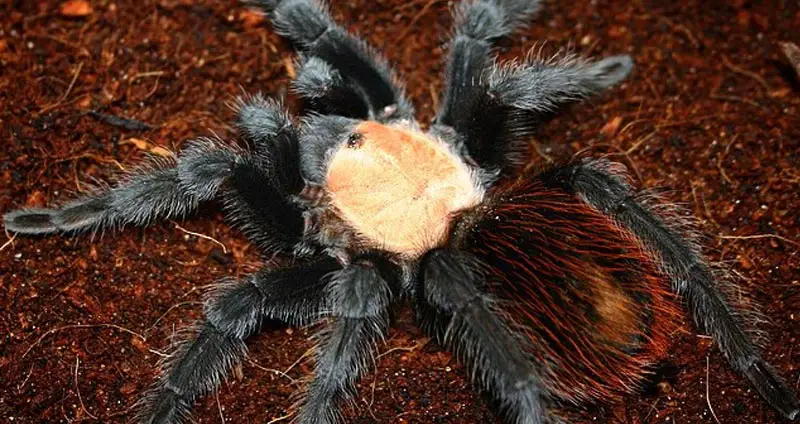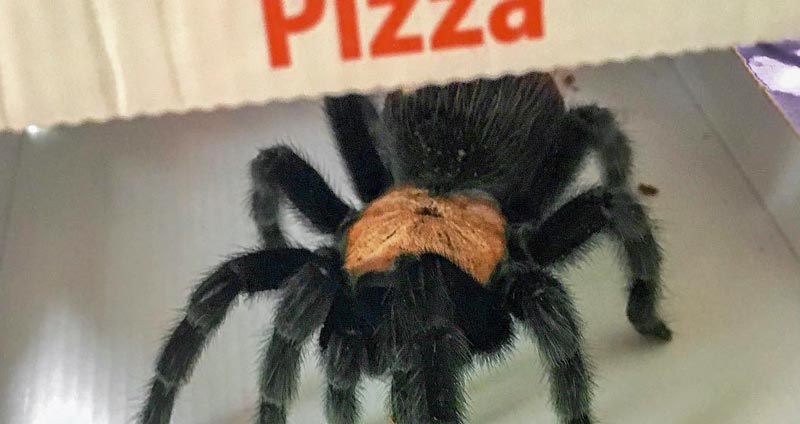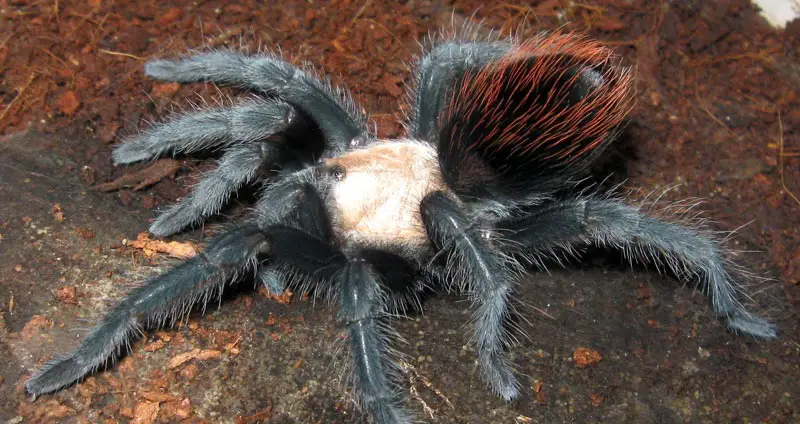Brachypelma albiceps, or the Mexican Golden Red Rump Tarantula, is a tarantula species that’s known for its great appearance and easy-going temperament.
Much like many other Brachypelma species, this particular tarantula is very popular in the pet trade and is beloved by beginner and experienced keepers alike.
This care sheet will tell you everything that you need to know about properly housing, feeding, and caring for your B. albiceps.
Table of Contents
Brachypelma albiceps Care Sheet
| Common Name |
Mexican Golden Red Rump |
| Species Type | New world terrestrial |
| Habitat | Found in savanna and scrubland regions of Mexico. |
| Growth Rate | Medium growth rate, growing an inch or so per year. |
| Adult Size | Females reach a legspan of about 6.5″, while males measure slightly smaller. |
| Lifespan | Females regularly live between 15 and 20 years, while males only live about 5 years. |
| Enclosure | The enclosure needs to be wider than it is tall with about 6 inches of substrate lining the bottom. There should be a hide, a fake plant, and a water dish present as well. |
| Temp/Humidity | 75°F to 80°F with about 60% to 70% humidity. |
| Diet | Great eater that can eat an adult cricket every day or two dubia roaches per week. |
| Temperament | An extremely docile tarantula that almost never flicks hairs or throws up a threat pose. Doesn’t have a lot of energy. |
| Experience Level | Beginner – A friendly tarantula that’s very easy to care for. Doesn’t pose much of a threat and has simple care requirements. |
| Average Cost | Slings ~ $40, Males ~ $80, Females ~ $130+ |
Brachypelma albiceps Appearance
While there are some Brachypelma tarantulas that have bright colors, this isn’t one of them. However, it’s still an appealing tarantula and unique in some aspects.
Brachypelma albiceps is a relatively stocky species that has blueish-black hairs on its legs, pedipalps, and underside. The carapace is a stunning gold/tan color, and this contrasts the red setae on the abdomen.
This coloration isn’t very visible in the spiderling stage, but it quickly develops as they mature. As in most tarantulas, colors are most vivid immediately following a molt.
In terms of sizing, adult females reach around 6.5″ in legspan, while males measure slightly smaller. They reach this size at an average pace due to their long lifespan of 20+ years (for females).

Brachypelma albiceps Temperament
The temperament of this tarantula is what makes it so popular and solidifies the species as a great pet.
Brachypelma albiceps is a new world tarantula, which are tarantulas that are known for their more laid-back personality, slower movements, and preference to run away from danger as opposed to fighting it.
This species is no exception to that classification. While personalities vary spider by spider, many owners describe their tarantula as a pet rock — calmly going about its life but always staying on display.
As new world tarantulas, these tarantulas do have venom, but it’s incredibly mild against humans and non-threatening. Instead, they depend on their irritating urticating hairs for defense.
Most owners will be quick to say that they rarely see their B. albiceps throw up a threat pose or flick hairs, though. If they do act defensively, often times it’s a male doing so.
Therefore, this very calm nature makes this a great display tarantula for beginners. However, if you’re looking for a tarantula that’s more entertaining, you’ll likely want to look elsewhere.
Housing Brachypelma albiceps
Housing this species is extremely simple and only requires a few specific things. However, their enclosure should be set up and 100% finished before you even bring this tarantula home.
Creating the optimal enclosure involves little more than acquiring the best terrarium and filling it with a few supplies.
Optimal Enclosure
As these are terrestrial tarantulas with a strong desire to burrow, providing them with a terrestrial enclosure is optimal.
Terrestrial tarantula enclosures primarily focus on providing a large amount of floor space and ground-level hiding places since terrestrial tarantulas rarely climb.
The best enclosure should have good security, cross-ventilation, accessibility, visibility, and plenty of space to walk around. For a tarantula of this size, it should also be decently large.
The Exo Terra 18″ × 18″ × 12″ terrarium is very suitable for an adult Brachypelma albiceps, as is the Repti Zoo 20″ x 12″ x 10″ enclosure. Both of these provide ample floor space to roam around and enough depth to create burrows.
Enclosure Decorations
The inside of the enclosure needs to be optimally-constructed for this Mexican species. In order to do this, there are some essential tarantula supplies you’ll need to provide.
The first step of decorating is lining the bottom of your tarantula’s enclosure with about 6 inches of moisture-retaining substrate, like coconut fiber. This allows for burrowing, cleanliness, and humidity retention.
A tarantula hide should also be provided for your B. albiceps to hide out in in order to feel more secure. Owners often opt for either coconut shells or cork bark hides.
The presence of a clean and consistent water source is also very important for tarantulas. A water dish that’s consistently maintained helps to quell dehydration in addition to keeping humidity levels consistent.
Once these needs are met, you can add a few extra decorations. Small rocks and fake plants help to round out the appearance of the enclosure.

Enclosure Temperature/Humidity
This is a tarantula that’s endemic to Mexico — specifically its central highlands. These areas are warmer, but don’t have excessive heat or humidity. So, this should be present in their enclosure.
For temperature, 75°F to 80°F is perfectly fine for this temperature. This is right around room temperature for most people, so supplemental heating is almost never required.
If your home drops below this range for extended periods of time, you would need to provide supplemental heating through either a space heater or a gentle heat lamp that doesn’t give off light.
Humidity levels around 60% to 70% are optimal. This can easily be maintained with a water dish and consistent misting of the substrate around 2-3 times per week.
It’s recommended that you use a thermometer/hygrometer to monitor environmental conditions so that you can make changes as needed.
Diet
This tarantula grows into a large, stunning creature that lives for a very long time, but that can only happen if it’s fed a good diet. Fortunately, it isn’t hard to provide this.
As spiderlings, Brachypelma albiceps eats flightless fruit flies and pinhead crickets. As they grow, you can transition them to larger crickets, mealworms, and dubia roaches.
Adult B. albiceps are excellent eaters that devour their food aggressively. Many owners feed their tarantula an adult cricket every day, but each specimen is different with what they require.
Health Concerns
Captive, pet tarantulas usually don’t have any specific health problems. As long as they’re kept in an optimal enclosure and fed a complete diet, there shouldn’t be any problems that arise.
The two most common problems that captive tarantulas run into are parasites/mites and dehydration — both issues that are easy to cure and prevent altogether.
It’s important to note that a sub-optimal enclosure for this species, such as one that’s not deep enough or one that doesn’t have enough floor space, could have negative health effects.
Small enclosures can cause unnecessary stress and prevent tarantulas from carrying out natural behaviors.
Brachypelma albiceps For Sale & Price
If you’re looking to bring home this tarantula, you shouldn’t have a hard time doing so. As these are such docile and beautiful tarantulas, they’re commonly bred for sale. Thus, they’re easy to find and cheap to purchase.
You can find Brachypelma albiceps for sale on a variety of different online marketplaces and in physical stores. Spiderlings tend to fetch a mere $40, while males sell for double that at $80. Females, living 20+ years, sell for around $130.
These prices can vary greatly, and there are many other costs of tarantula ownership, but it’s obvious that this is a very affordable tarantula.
So, if you’re looking for a friendly tarantula that’s easy to care for and hardly poses a threat to its owner, look no further than this species! There’s a reason it’s one of the first tarantulas that many people own.

